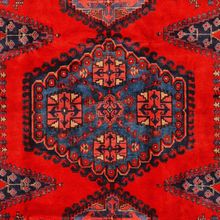Difference between revisions of "Viss Rug"
| Line 53: | Line 53: | ||
=== Motifs and patterns === | === Motifs and patterns === | ||
=== Weaving techniques === | === Weaving techniques === | ||
| − | |||
| − | |||
== See also == | == See also == | ||
== References == | == References == | ||
Revision as of 08:02, 4 December 2019
| Viss Rug | |
|---|---|
 Design of Viss Rug (Rugman) | |
| General information | |
| Name | Viss Rug |
| Original name | قالي ویست |
| Alternative name(s) | Viss Carpet |
| Origin | |
| Category | Village |
| Technical information | |
| Common designs | Geometric, Herati (Fish) |
| Common colors | Red, Beige, Blue, Navy Blue |
| Dyeing method | Natural, Synthetic |
| Pile material | Wool |
| Foundation material | Cotton |
| Knot type | Symmetrical (Turkish) |
Wiss rugs originate from Wiss, also referred to as Viss, a small town located near Hamadan. However, for a small town, Wiss has an eclectic mix of population. Kurds, Turks, and the nomadic people of Bakhtiari all call Wiss home, and it is the influence from these diverse groups that is an integral part of the weaving of wool rugs here. Due to its largely nomadic population, the majority of Wiss rugs feature geometric designs, which is an indication of a tribal rug. Its location so close to Hamadan has influenced the local weavers to create their wool rugs using the Hamadan weave, also referred to as the Sennah Baft. These wool rugs are woven with a Turkish symmetrical knot and a single shot of weft between the rows of knots
History
Viss is a village located in the Markazi Province of central Iran. Viss carpets are known in the market from the second quarter of the twentieth century. They were popular in Europe as one of the few geometric room-size types with tribal design elements. These carpets were an alternative choice to the HERIZ weavings of northwestern Iran, which were in demand by the world floor covering markets.
By the last quarter of the twentieth century, some Viss weavers switched from traditional designs and made carpets and rugs similar to other neighboring areas according to the demand of domestic and foreign consumers.[1]
Materials
Foundation and Pile
The carpets have a cotton foundation and a wool pile.[2]
Techniques and structures
Color and dyeing
Viss field and border colors are mostly reds, dark blue, and ivory. Additionally, different shades of blue, green, brown, coral, gray, and gold appear in the medallions, design elements, and outlines.[3]
Motifs and patterns
Weaving techniques
See also
References
Bibliography
Abraham Levi Moheban, (2015), The Encyclopedia of Antique Carpets: Twenty-Five Centuries of Weaving, NewYork: Princeton Architectural Press.